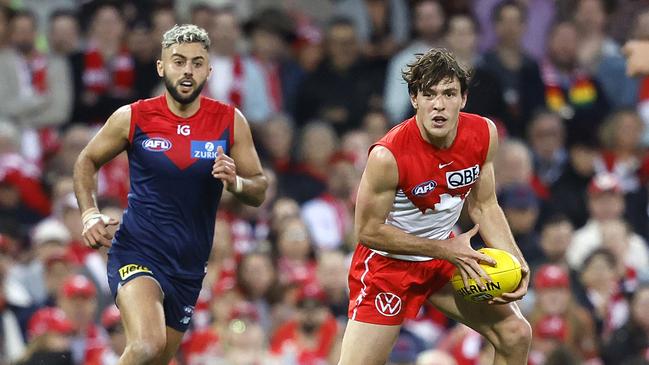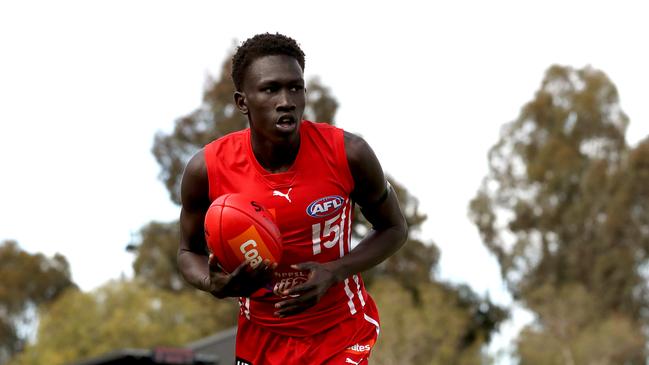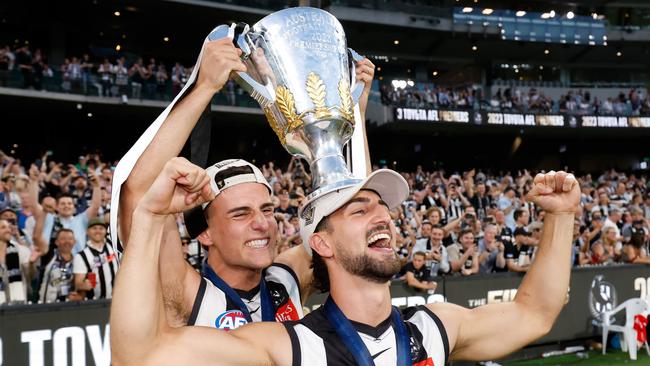How the AFL academy system has reached a breaking point in the eyes of clubs
With the Suns landing four academy guns in this year’s draft, JAY CLARK looks at the system that clubs believe ‘has reached a breaking point’. Plus the numbers behind every team’s academy picks.
AFL
Don't miss out on the headlines from AFL. Followed categories will be added to My News.
Damien Hardwick might be the happiest man in football this week.
The new Gold Coast coach has taken over the most under-performed club of the past 10 years and will welcome in Monday night’s national draft four academy stars in the first 25 picks.
There’s tackle-made key forward Jed Walter, who recruiters say will be “the most feared forward in the game”, running ruck machine Ethan Read, livewire Jake Rogers and explosive defender Will Graham.
Said a rival talent scout this week: “People don’t realise it yet, but they (Suns) have got Josh Kennedy, Dean Cox and Daniel Kerr coming through, if they can develop them right.”
While the headlines have focused on West Coast’s plot for Harley Reid and Daniel Curtin, recruiters believe the Suns’ quartet are really the big story of the 2023 draft as tension increases about the hit-and-miss academy program.

Next year, the Suns have access to dynamite ballwinner Leo Lombard, an underage All-Australian midfielder who remarkably played VFL this year aged only 16 – and athletic forward Caleb Nancarrow.
He’s a Jamarra Ugle-Hagan type.
Maybe, that’s two more guns.
But as much as the AFL is desperate to see Gold Coast climb the ladder under ‘Dimma’ after a disastrous decade - where the Suns lost a string of superstars to rivals at trade time – clubs believe the academy system has reached a breaking point.
Herald Sun analysis shows that while the four northern states clubs have hit the talent jackpot through its academies – snaring Callum Mills, Errol Gulden, Tom Green and Eric Hipwood among many others over the past decade– many other clubs have missed out.
Over the past eight years since the next generation academies were introduced for the 14 other clubs, four of those clubs – Melbourne, Geelong, Carlton and Adelaide – have taken only two players each via their own academy.
And the two Cats (Ted Clohesy and Blake Schlensog) have played one game combined, the two Crows (Tariek Newchurch and James Borlase) managed four matches and the two Blues (Domanic Akuei and Harrison Macreadie) appeared nine times.
Essendon has picked five players totaling nine games and West Coast has also taken five for 14 matches since 2016.
That is in contrast to Western Bulldogs who landed superstar forward Jamarra Ugle-Hagan from Framlingham and Collingwood’s snatch-and-grab for premiership defender Isaac Quaynor, from Oakleigh.
But since those two came through, the rules have changed.
Now clubs have no rights to any of their own academy players taken in the top-40, so all the guns which come through the NGA’s (excluding Queensland and New South Wales players) can go anywhere, anyway.
So it’s been a case of boom or bust, feast or famine on the academy front.
Of the 124 AFL players taken in the academy system over the past decade, 43 have played 0 games. That is one third.
Seventy-two academy products have played 10 AFL games or less.
Five have made All-Australian. There are about 15 stars active.

But it’s what is coming through the pipelines at Gold Coast over the next 12 months and disbelief at the current restrictions on clubs claiming their own players inside the first 40 picks that has fueled suggestions the academy system is “broken” or at best, more compromised than it has ever been before.
As Port Adelaide football boss Chris Davies said: “The AFL has some decisions to make with regard to what they want the draft to actually look like.”
“This year and the next few years are going to be highly compromised.”
As things stand, the 14 clubs with next generation academies don’t have guaranteed access to any of their own academy players if they are picked in the first 40 selections, to prevent clubs from landing more Ugle-Hagans or Quaynors at the pointy end of the draft.
The whole point of the next generation academy system was to teach players who weren’t brought up on Australian Rules the game, but in Ugle-Hagan and Quaynor’s case, the Dogs and Pies just got lucky.
They were stars of their junior teams, and were most likely always going to be guns, and taken early in the draft, regardless of their academy status. The Dogs and Pies won the draft lottery, there.
So the AFL clamped down in 2021 and 2022. Instead of having free reign, clubs now only have exclusive rights to their next academy stars after pick 40.
It is why Melbourne missed out on Gold Coast’s Mac Andrew, and St Kilda watched on as Hawthorn took Cam McKenzie last year.
Dagger blows.
This year, West Coast academy product Lance Collard could be taken well inside the first 40 by a rival, and North will miss out on Tasmanian NGA star Riley Sanders.

Hawks have Tew Jiath, there’s the Dogs’ Luamon Lual, Fremantle’s Mitch Edwards and Sydney’s Caiden Cleary all in the mix.
It is why the Eagles want the system changed to be more advantageous to the clubs who spend the time and money helping develop junior players from their zone who have an Indigenous or multi-cultural background.
“We have been liaising with the league and we have written to them a number of times to see whether there is an opportunity to change the rules,” former CEO Trevor Nisbett said.
“It needs to be changed. There is such a disparity between the rules now, between the categories – it needs to change.”
The top-40 restriction is in contrast to the rights of the four northern-states academies – Brisbane, Gold Coast, Sydney and GWS Giants - who have exclusive access to all of their academy players so long as they have enough draft pick points to match.
It is how Sydney plucked best and fairest winner Errol Gulden with pick 32.
Geelong was the bidder.
And why Gold Coast have banked picks 24, 26, 27, 32, 36, 38, 66, 71, 74, 84 to land prized quartet Walters, Read, Rogers and Graham on Monday night to help kick-start the club’s finals charge under Hardwick.
There are some good intentions, clearly, to develop players in regional areas, put Sherrins instead of soccer balls in kids’ hands, and generally spread the love and participation of Australian Rules.
For the New South Wales and Queensland clubs, the northern academies help supply crucial local talent – to help bolster retention rates – and provide a chance to compete against the Victorian heavyweights where the bulk of the AFL talent originates.
So for the Swans and Suns etc, the academies give them a chance to develop and keep local stars. Combat the cost of living.
But the opposing view suggests the academy system is terribly lopsided – despite the historical advantage Victorian clubs have with the father-son rule.
That’s Collingwood’s Nick and Josh Daicos, Geelong superstars Gary Ablett and Tom Hawkins, and Bulldogs’ Tom Liberatore, to name only a few.

But the NGA areas – and the boundaries which divide them – are a source of recruiting angst.
To nominate for a club’s next generation academy in Victoria, South Australia and Western Australia, the junior player either need to be Indigenous or have one parent born overseas.
But they must reside in the clubs’ zones, which is a mix of country and metro areas drawn up by the AFL using mystery metrics in 2016.
Collingwood and St Kilda (Mitch Owens and Marcus Windhager) have fertile slivers of eastern and bayside Melbourne, which takes in highly-regarded private schools, while Western Bulldogs (Ugle-Hagan) have a huge chunk of western Victoria taking in Ballarat and Warrnambool.
North Melbourne (Tarryn Thomas) has Tasmania and Hawthorn (Changkuoth Jiath) has a huge stretch of Eastern Victoria stretching from Burwood to far-east Gippsland.
Northern Territory is split between six clubs. But it is hit and miss.
And the motivations behind the academy system have been debated behind closed doors.
Said one recruiter, in terms of footy talent, “some of the next generation academy zones have been really barren catchment areas”.
“If we are honest about it, the next generation academies are a political exercise to try and off-set the significant advantage the northern-states clubs have with their academies, and all the players they get access to that other clubs can’t touch,” he said.
“It isn’t a fair or equitable system.”
But the northern states clubs say the same about the father-son rule and the go-home factor for Victorian players.
The next generation academy zone boundaries were drawn based on a “range of factors” including population statistics, according to former AFL operations manager and current Suns’ CEO Mark Evans.
“It is important to note that hubs have been established on the basis of multicultural populations in each state,” Evans said in 2016.
But with the current top-40 restriction, the question is now being asked as part of a league-wide review - why should clubs put in the time, money and investment in NGA academies if they can only get their hands on late prospects and rookie equivalents?
It is why there is a strong push to reduce the top-40 restriction to only top-10 or top-20, so more clubs can get their hands on more of their own NGA players.
Otherwise, their interest in driving the NGA programs (for children aged 10 and upwards) may dwindle.
After all, there are serious development programs, which require a decent level of investment, and then there are kick-and-giggle clinics.
In any case, the money sits outside the football department cap, but it still costs.
And the rewards are significantly varied.





